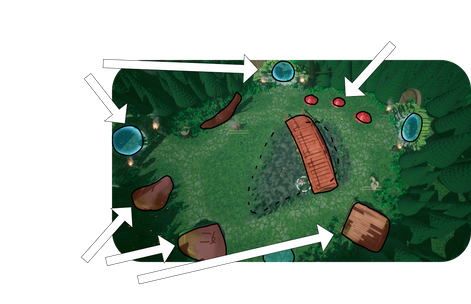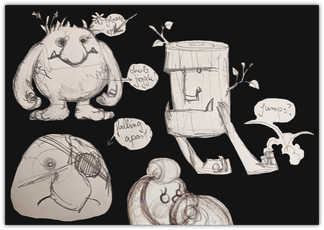
A Reverse Hot Potato, King of The Hill Battler made at FutureGames. As one of the eternal trolls, you are to capture the most delicious meal — the Lost Baby.
Your goal is to pick up the baby and hold on to it until you win. But watch out, the other trolls are going to try their best to take it for themselves.
Project Details
Platform:
Genre:
Engine & Tools:
Development:
Team Composition:
PC
Local Multiplayer Brawler
Unreal Engine, Blueprints
2 weeks
3 Designers, 3 artists
Character Mechanics Design
Implemented character mechanics, interactions, and conditions along with the team.
Systems & Technical Design
Implemented the core functionality, multiplayer contols, and the competition conditions.

There were three parts to the core design that were iterated on, on a technical level:
I worked mainly on the character mechanics, and the multiplayer mechanics.
My goal was to make the character mechanics feel nimble, precise, and useful. We were consistently asking ourselves - how do we make this game more engaging?
We decided on fast movement and the abilities of Dashing, Punching and even Throwing the baby.
With the use of intense game-testing, the abilities were iterated on to have their use counter eachother. Punches blocked throws; Throws cought dashes; Dashes outran punches.

PUNCHING
THROWING
DASHING
The abilities were balanced in collaboration with the awesome level designer on the team.

Since my design goals were set early on, I focused my efforts on learning correct technical solutions to Baby ConTroll's controls, core loop, and functionality. My main focus was the central mechanic — the actual "Baby Control".
While the baby itself was bouncing actor with a little bit of flair, the core gameplay revolved around the mechanics of grabbing, holding and throwing the baby. This mechanic is basically how the player wins, loses, and even fights back.
The Grabbing and Holding system.
There were many steps to the grabbing & holding system, so a three step strategy worked better on a catergorical level. The nitty-gritties were given more space than that:
The Throwing mechanic.
The throwing mechanic worked in tandem with the grab & hold system. In hindsight, I would have rather used trace functions than collision functions, and used a more interfaced code.
While it was not my initial intent, I found that any coding worked much better if I consistently followed this three-step structure. It's something that I have brought with me since before this project, but it was good ability to have going in to it.

As I had previous project management experience, I happily accepted the role. My responsibilities were:
On this subject, I was making sure that people always had something to do, and that no one was overworked. Though I had managed other projects before, this was my first game project.
There were many similarities - such as communication, meetings and follow-ups, as well conflict management. However, the assignments themselves, as well as how to track them is something I learned a lot about. Since we were still able to be next to each other during this project, things like utilizing Trello and Perforce synchronization was an easy addition.


On this subject, my role was following up on the ideation, prioritization of features, and managing scope. Most importantly, I learned how to act on needs for re-prioritization and initial prioritization in order to successfully construct games from game ideas quickly.
While I brought up ownership for this project, it was not the first time I had pushed for this value. For any successful project, it is important that the team feels invested, and happy to partake. As such, all ideas presented had a place in the game we were making, if it was plausible to make it.


As my first major entry to Unreal Engine, I learned to use the game engine as a way to rapidly test out systems. This set me on the path of rapid prototyping, elaborative iteration and gameplay design.
I also learned a lot about how project management works in a game project, and how to better use this skill-set in this context.